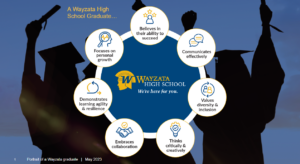If you were to ask yourself what the quote-on-quote portrait of a high school graduate looked like, what would you envision? More importantly, what does it take to get that student there? The process and characteristics of student preparedness look different in every school, but oftentimes they may seem as if they’re simply a poster. “This is how we prepare students for a life post-graduation.” But what does preparedness really mean? And more importantly, do the students themselves understand their role to get there?
These are the million-dollar questions that Scott Gengler, principal at Wayzata High School in Plymouth, Minnesota wants to answer. Home to nearly 4,000 students, Gengler says things at Wayzata feel great as he reflects on his first “normal” school year since the pandemic.
“When we were taken out of our normal routine for those two years, we had to really learn how to play school all over again,” he says. “We forgot how to do school and do school well.”
As principal, he says that’s been the biggest challenge for him and his team the past few years. But this summer, he’s taking on a new challenge: to pioneer their version of a “portrait of a Wayzata graduate.” And their promise is to ensure every student graduates prepared for post-secondary success, regardless of race, class, gender, or ability level.
“Those indicators won’t predict students’ success,” he says. “At least, it won’t predict the students’ preparedness as they make decisions for postsecondary.”
In order for Gengler and his staff to deliver on that promise, they first had to ask themselves, what does the word prepared actually mean?
“For a long time, people looked at preparedness from an academic standpoint,” he explains, in addition to other important measures including career and technical education and other core classes that are meant to promote certain standards.
“But I’m not sure kids see the relevancy all the time,” he says. “They might see the relevance in a career-type course. But, for example, if I ask an English teacher, ‘What is it that you’re really doing and what is it that you’re trying to help students learn and develop?'”
More from DA: Leadership snapshot: This superintendent believes community schools can keep K12 relevant
Most would probably tell you that they’re teaching kids to think critically, he adds. And while that may be the standard, Gengler says he’s pretty certain that’s not what the student takes away from it and shares with his parents when they ask what they learned at school.
“There’s this real disconnect between what we think we’re doing and what we’re probably doing a pretty good job of, and our kids really seeing that,” he explains. Additionally, students should be connecting certain attributes and traits that are going to help them be successful in life post-high school.
After a great deal of thought, Gengler and his team narrowed down seven traits they believe are necessary for developing what they believe to be a prepared Wayzata graduate.

“We are going to try to bring some relevancy behind what we’re doing in the classroom and students being able to see their growth as it correlates to those individual traits,” he says.
Because students often view the work that they’re doing simply as content, he explains, it’s up to educators to foster this newfound perspective toward school work. The content is only there to help students develop those seven traits, Gengler says. For instance, one common standard in schools is to support students in learning to communicate effectively.
“But I’m not sure a student sees that connection behind the work we’re doing in the classroom that’s really helping them develop a skill that’s going to make them more employable or more college ready,” he says. “As a staff, we do a pretty good job teaching a standard and assessing that standard. I don’t think kids necessarily see the learning of that standard and are able to apply that to their future success.”
But how do you measure a student’s growth in a particular trait? Simply put, it’s up to the student to self-assess and for the teacher to identify which traits are relevant to their instruction.
“Everything we do should be tied to the growth and development of that particular trait,” he explains. “This isn’t about me assessing whether or not you got there. It’s about a student being able to see and attribute what they’re doing as an opportunity to grow in that area and they can self-assess their skillset as it correlates to those traits.”
“I would love for a student to go home and say, ‘Well, I took chemistry so that I can question my own thinking and develop a variety of solutions to problem-solving.’ We want kids to look at their experience in the classroom as a development of their personal attributes and skills as it correlates to their employability and their readiness for any one of their postsecondary options.”









